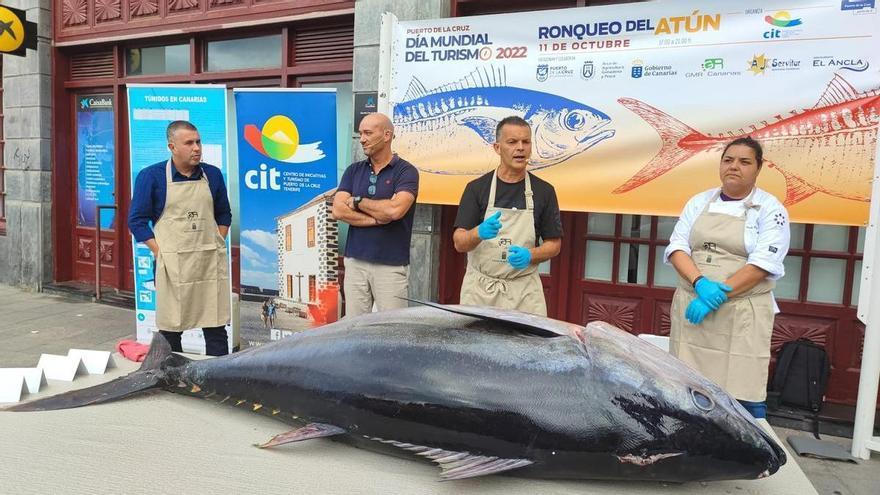
Of tuna, like the pig, practically everything is used, but you have to know how to extract the numerous parts with culinary use that a tuna can offer. The Tourist Initiatives Center (CIT) of Cross port organized on the afternoon of this Tuesday, October 11, a master class on this art, given by the chef Juan Carlos Clementein the first edition of Tuna Ronqueoan activity conceived to commemorate world tourism day and offer the visitor new experiences that connect the local fishing tradition and gastronomy. Exploded view of a Thunnus obesus of 100 kilospopularly known in Canary Islands as bigeye tuna, caught the attention of a large audience, willing to enjoy a process that goes from the sea to the mouth.
The term ronqueo refers to the raucous sound produced by the knife when cutting the hardest parts of the tuna. All an art that Juan Carlos Clemente has perfected over years in which he has learned from the best in Zahara de los Atunes, in Cadiz. Although some raise the figure to about 25 usable parts, Clemente prefers to talk between 14 and 16“according to the size of the tuna, since there are areas that can only be used from certain dimensions.”
In restaurants like The anchorin MedanoClemente takes about 30 minutes to complete the butchering of a tuna, but this Tuesday, with the pertinent explanations, the duration of the process practically doubled. On Las Lonjas street, next to the pier and the Customs House, was extracting before the public parts such as the morrillo, the ventresca, the loins, the sirloin, the tarantelo, the mormo, the facera or the discharge. Without forgetting that of the tuna “The bones are used for broths, the head to make stocks, the guts for tripe, the heart and even the eyes”. All proceeds were later donated tol Santa Rita Home.
«The most complicated part of this is not the cut, but the process of catching the tuna, which is done with live bait, and its treatment in the first moments on the boat. It is very important that the tuna is bled on board, even if between 10 and 12 kilos are lost, the quality improves a lot. Another key is to cool it down very quickly so that it doesn’t affect the flavour,” Clemente details. This chef misses the fact that the tuna fished in Canary Islands is processed on the islands, which exports more than it consumes and, even, there is the paradox that it ends up consuming tuna fished in the Archipelago that are taken to be processed outside before returning frozen and more expensive. “Nonsense,” he laments..
After bringing tuna ronqueo to the tourist city, the Porto CIT organized a tapas service with multiple preparations with this appreciated blue fish, the work of the chefs of three prestigious restaurants in the area: El Calderito de la Abuela, Mirador de Garachico and Zumaque. The sweet spot put it Ivan’s Bakery and the pairing was carried out by Tajinaste Wineriesrepresented by Agustin Garcia Farras. A different day in which historical routes through the city were also organized in Spanish, English and German, thanks to the collaboration of AJ Servitur Tourist Services. The music was provided by the folkloric group Princesa Iraya.
This innovative conference had the collaboration of the Ministry of Agriculture, Livestock and Fisheries of the Government of the Canary Islandsthrough the public trading company Management of the Rural Environment of the Canary Islands; the Cabildo of Tenerifeand the Municipality of Puerto de la Cruz.















